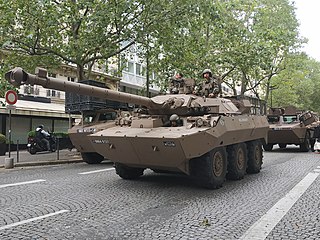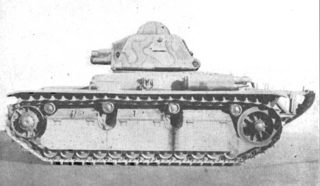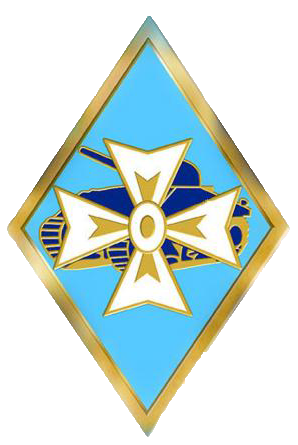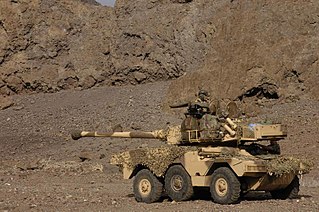Related Research Articles

The Leclerc is a third-generation French main battle tank developed and manufactured by Nexter Systems. It was named in honour of Marshal Philippe Leclerc de Hauteclocque, a commander of the Free French Forces, who led the 2nd Armoured Division in World War II.

The AMX-13 is a French light tank produced from 1952 to 1987. It served with the French Army, as the Char 13t-75 Modèle 51, and was exported to more than 26 other nations. Named after its initial weight of 13 tonnes, and featuring a tough and reliable chassis, it was fitted with an oscillating turret built by GIAT Industries with revolver-type magazines, which were also used on the Austrian SK-105 Kürassier. Including prototypes and export versions, over a hundred variants exist, including self-propelled guns, anti-aircraft systems, APCs, and ATGM versions.

The AMX-30 is a main battle tank designed by Ateliers de construction d'Issy-les-Moulineaux and first delivered to the French Army in August 1966. The first five tanks were issued to the 501st Régiment de Chars de Combat in August of that year. The production version of the AMX-30B weighed 36 metric tons, and sacrificed protection for increased mobility. The French believed that it would have required too much armour to protect against the latest anti-tank threats, thereby reducing the tank's maneuverability. Protection, instead, was provided by the speed and the compact dimensions of the vehicle, including a height of 2.28 metres. It had a 105 mm gun, firing a then advanced high-explosive anti-tank (HEAT) warhead known as the Obus G. The Obus G used an outer shell, separated from the main charge by ball bearings, to allow the round to be spin stabilized by the gun without spinning the warhead inside which would disrupt jet formation. Mobility was provided by the 720 horsepower (540 kW) HS-110 diesel engine, although the troublesome transmission adversely affected the tank's performance.

The AMX-10 RC is a French armoured fighting vehicle manufactured by Nexter Systems for armoured reconnaissance purposes. Equipping French cavalry units since 1981, over 240 remained in service with the French Army in 2021. 108 units were sold to Morocco and 12 to Qatar. "RC" stands for "Roues-Canon", meaning "wheeled gun". English language newspapers have often incorrectly referred to it as a light tank, a mistranslation of the French term "char", which refers to a wider category of armoured fighting vehicles than the English word "tank".

The Lorraine 37L or Tracteur de ravitaillement pour chars 1937 L, is a light tracked armoured vehicle developed by the Lorraine company during the interwar period or interbellum, before the Second World War, to an April 1936 French Army requirement for a fully armoured munition and fuel supply carrier to be used by tank units for front line resupply. A prototype was built in 1937 and production started in 1939. In this period, two armoured personnel carriers and a tank destroyer project were also based on its chassis. Mainly equipping the larger mechanised units of the French Infantry arm, the type was extensively employed during the Battle of France in 1940. After the defeat of France, clandestine manufacture was continued in Vichy France, culminating in a small AFV production after the liberation and bringing the total production to about 630 in 1945. Germany used captured vehicles in their original role of carrier and later, finding the suspension system to be particularly reliable, rebuilt many into tank destroyers of the Marder I type or into self-propelled artillery.

The FCM F1 was a French super-heavy tank developed during the late Interbellum by the Forges et Chantiers de la Méditerranée (FCM) company. Twelve were ordered in 1940 to replace the Char 2C, but France was defeated before construction could begin, a wooden mock-up being all that was finished. The FCM F1 was large and elongated, and had two turrets: one in front and one in the back, with a single high-velocity gun in each turret. The rear turret was superfiring, meaning it was raised higher and fired over the top of the forward one, a common practice in naval vessels. The vehicle was intended to be heavily armoured. Its size and protection level made it by 1940, at about 140 tons, the heaviest tank ever to have actually been ordered for production. Despite two engines its speed would have been low. The primary purpose of the tank was to breach German fortification lines, not to fight enemy tanks. The development path of the FCM F1 was extremely complex, due to the existence of a number of parallel super-heavy tank projects with overlapping design goals, the specifications of which were regularly changed. For each project in turn several companies submitted one or more competing proposals.

The Renault R40 or Char léger modèle 1935 R modifié 1939 was a French light infantry tank that was used early in World War II, an improvement of the Renault R35, of which it is often considered a variant.

The ARL 44 was a French heavy tank and tank destroyer, the development of which started just before the end of the Second World War. Only sixty of these tanks were ever completed, from 1949 onwards. The type proved to be unsatisfactory and only entered limited service. The tank was phased out in 1953.

The 7th Armoured Division was an armoured division of the French Army. The division was active during the Cold War and some time after the fall of the Berlin Wall, before being disbanded. Its traditions were carried on by the 7th Armoured Brigade.

The 1st Armored Division is a unit of the French Army formed during World War II that took part in the Liberation of France.

The 3rd Armoured Division is a unit of the French Army. The Division is the heir of the 3rd Algerian Infantry Division formed in 1943 and dissolved in 1946, which contributed in the liberation of Marseille during the Second World War.

The AMX 50 or AMX-50 is a French heavy tank designed in the immediate post Second World War period. It was proposed as, in succession, the French medium, heavy, and main battle tank, incorporating many advanced features. It was cancelled in the late 1950s however, due to unfavourable economic and political circumstances after serious delays in development.

The AMX-VCI is one of the many variants of the French AMX-13 light tank. It was the front line APC of the French Army until replaced by the AMX-10P. It is still used by some countries, for example Mexico, where it goes under the name of DNC-1 and is armed with a 20mm cannon.

The Armoured Cavalry Arm is a component of the French Army. It was formed after World War II by merging the combat tank and cavalry branches. It operates the majority of France's armoured vehicles, though a small minority of France's armour is still operated by infantry regiments. It continues the traditions of the French cavalry and combat tank branches from which it is descended, as well as those of the defunct horse artillery, from which it is not actually descended.

The following is a hierarchical outline for the French Land Army at the end of the Cold War. It is intended to convey the connections and relationships between units and formations. The theoretical combat strength of the army was 295,989 soldiers, of the 557,904 individuals available for service across the entire French Armed Forces in 1989.

French development into tanks began during World War I as an effort to overcome the stalemate of trench warfare, and largely at the initiative of the manufacturers. The Schneider CA1 was the first tank produced by France, and 400 units were built. The French also experimented with various tank designs, such as the Frot-Laffly landship, Boirault machine and Souain experiment. Another 400 Saint-Chamond tanks were manufactured from April 1917 to July 1918 but they were underpowered and were of limited utility because the caterpillar tracks were too short for the tank's length and weight. The most significant French tank development during the war was the Renault FT light tank, which set the general layout for future tank designs and was used or redesigned by various military forces, including those of the United States.

The ELC project was a prototype light tank project launched by the French Ministry of Defense in 1955. The purpose of the ELC project was to develop a lightly armoured, heavily armed fighting vehicle capable of being airlifted for rapid deployment.

The Batignolles-Chatillon Char 25T was an early Cold War medium tank of France, developed in 1954 by the Batignolles-Chatillon company. The vehicle was not developed beyond the two prototypes.
The AMX 38 was a prototype French tank designed in 1937 at the AMX works. Designed as AMX's response to the 20-tonne tank programme intended to replace the aging Char D2, it was a faster and heavier alternative to Renault R35, in practice a cross-over between a light tank and medium tank.
The FCM 50t was a French heavy tank design of the 1940s. It did not progress beyond drawing stage.
References
- 1 2 3 4 5 MISNER, Antoine. "1946 AMX CHASSEUR DE CHAR". Chars Français (in French). Archived from the original on 2018-01-13. Retrieved 2017-05-01.